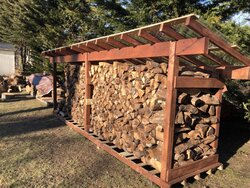Hey Everyone.
Looking for a little guidance to prep for next year. White/red oak is reading about 21%-22% right now. Do you think this will be ready for next season? Everyone around here sells cords that have only been split for about 1 year, so I just want to get my head straight if I need to start searching for dry wood.
Any insight from the folks here who season a lot of oak would be really appreciated.
Thanks again!
Looking for a little guidance to prep for next year. White/red oak is reading about 21%-22% right now. Do you think this will be ready for next season? Everyone around here sells cords that have only been split for about 1 year, so I just want to get my head straight if I need to start searching for dry wood.
Any insight from the folks here who season a lot of oak would be really appreciated.
Thanks again!



 I have no idea how accurate this conversion table is, but it is from Delmhorst a respected moisture meter manufacturer. It is from their website, so should be OK for me to post it here.
I have no idea how accurate this conversion table is, but it is from Delmhorst a respected moisture meter manufacturer. It is from their website, so should be OK for me to post it here. The actual moisture content is 28%.
The actual moisture content is 28%.